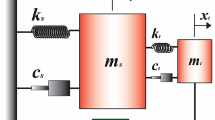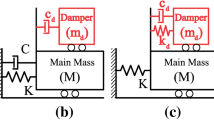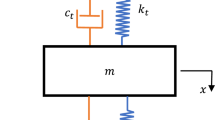Abstract
A number of studies are reported in the literature on tuned mass damper (TMD) designed as per the optimum tuning frequency and optimum damping ratio. Many of the closed-form equations proposed in the literature for optimum tuning frequency and optimum damping ratio are applicable for single-degree-of-freedom systems. Equation proposed in the literature for optimum damping ratio for multi-degree-of-freedom system results in a higher value of optimum damping ratio. In the present study, optimum tuning frequency and optimum damping ratios of shear-type multi-storey buildings are obtained by combining numerical time history analysis with optimization using minimax optimization function. Closed-form equations are fitted with one thousand eight hundred and ninety optimization results for three multi-storey buildings with nine ground motions for ten mass ratios and seven damping ratios. Equations proposed are applied for a number of single-degree-of-freedom and multi-degree-of-freedom systems, and it is observed that optimum parameters obtained through the equations proposed in the present study result in optimum response reduction with economical damping ratio. Further, applicability of the closed-form equation for site-specific earthquake including the depth of soil stratum is investigated and observed that equations proposed in the present study are able to predict more appropriate values of optimum tuning frequency and optimum damping ratio which can help in the design of TMD with economical damping ratio.




Similar content being viewed by others
References
J.P. Den Hartog, Mechanical vibration (McGraw-Hill, New York, 1956)
G.B. Warburton, Optimum absorbers parameters for various combinations of response and excitation. Earthq. Eng. Struct. Dyn. 10, 381–401 (1982)
H.C. Tsai, G.C. Lin, Optimum tuned-mass dampers for minimizing steady-state response of support-excited and damped systems. Earthq. Eng. Struct. Dyn. 22, 957–973 (1993)
F. Sadek, B. Mohraz, A.W. Taylor, R.M. Chung, A method of estimating the parameters of tuned mass dampers for seismic applications. Earthq. Eng. Struct. Dyn. 26, 617–635 (1997)
A.K. Chopra, Dynamics of structures: theory and applications to earthquake engineering (Prentice-Hall, Upper Saddle River, 2000)
T.T. Soong, G.F. Dargush, Passive energy dissipation systems in structural engineering (Wiley, England, 1997)
P. Lukkunaprasit, A. Wanitkorkul, Inelastic buildings with tuned mass damper under moderate ground motions from distant earthquakes. Earthq. Eng. Struct. Dyn. 30, 537–551 (2001)
J.G. Johnson, L.D. Reaveley, C. Pantelides, A rooftop tuned mass damper frame. Earthq. Eng. Struct. Dyn. 32, 965–984 (2003)
R.A. Islam, Optimization of tuned mass damper parameters using evolutionary operation algorithm. in Proceedings of 15th world conference on earthquake Engineering Lisbon, Portugal, pp. 1–7 (2012)
M.N.S. Hadi, Y. Arfia, Optimum design of absorber for MDOF structures. J. Struct. Eng. ASCE 124(11), 1272–1280 (1998)
B. Brown, T. Singh, Minimax design of vibration absorbers for linear damped systems. J. Sound Vib. 330(11), 2437–2448 (2010)
L. Zuo, S.A. Nayfeh, Minimax optimization of multi-degree-of-freedom tuned-mass dampers. J. Sound Vib. 272, 893–908 (2004)
J. Salvi, E. Rizzi, M. Gavazzeni, Analysis on the optimum performance of Tuned Mass Damper devices in the context of earthquake engineering. in Proceedings of the 9th international conference on structural dynamics, EURODYN 2014 Porto, Portugal (2014)
J. Salvi, E. Rizzi, Optimum tuning of tuned mass damper for framed structures under earthquake excitation. Struct. Contr. Health Monitor. 22, 707–725 (2015)
A. Ghosh, B. Basu, A closed form optimal tuning criterion for TMD in damped structures. Struct. Contr. Health Monitor. 14, 681–692 (2007)
M.M. Murali, S.M. Mane, Seismic effectiveness of tuned mass damper (TMD) for different ground motion parameters. in Proceedings of 13th world conference on earthquake engineering, Vancour, Paper No. 2325 (2004)
P. Kamatchi, K. Balaji Rao, G. Abhishek, Response reduction of structural system with tuned mass damper for site-specific earthquake including the effect of depth of soil stratum. Asian J. Civ. Eng. (BHRC) 17(5), 659–674 (2016)
M.-Y. Liu, W.-L. Chiang, J.-H. Hwang, C.-R. Chu, Wind-induced vibration of high-rise building with tuned mass damper including soil–structure interaction. J. Wind Eng. Ind. Aerodyn. 96, 1092–1102 (2008)
K.N. Khattri, An evaluation of earthquakes hazard and risk in northern India. Himal. Geol. 20, 1–46 (1999)
P. Kamatchi, Neural network models for site-specific seismic analysis of buildings, Ph. D. thesis, Department of Civil Engineering, Indian Institute of Technology, Delhi (2008)
N.D. Satyam, Seismic microzonation studies for Delhi region, Ph. D. thesis, Department of civil engineering, Indian Institute of Technology, Delhi (2006)
M. Vucetic, R. Dobry, Effect of soil plasticity on cyclic response. J. Geotech. Eng. 1(117), 89–107 (1991)
Acknowledgement
This is paper is published with the kind permission of the Director CSIR-SERC.
Funding
Not applicable.
Author information
Authors and Affiliations
Corresponding author
Additional information
Publisher's Note
Springer Nature remains neutral with regard to jurisdictional claims in published maps and institutional affiliations.
Rights and permissions
About this article
Cite this article
Kamatchi, P., Balaji Rao, K. & Sathish Kumar, K. Closed-Form Equations for Optimum Tuning Frequency and Damping Ratio of Tuned Mass Damper and Applicability for Site-Specific Earthquakes. J. Inst. Eng. India Ser. A 101, 19–26 (2020). https://doi.org/10.1007/s40030-019-00417-4
Received:
Accepted:
Published:
Issue Date:
DOI: https://doi.org/10.1007/s40030-019-00417-4




